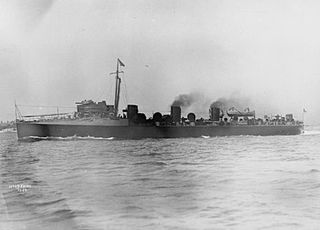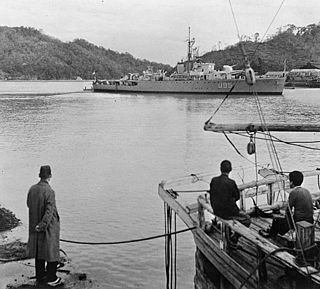
The Royal Indian Navy (RIN) was the naval force of British India and the Dominion of India. Along with the Presidency armies, later the Indian Army, and from 1932 the Royal Indian Air Force, it was one of the Armed Forces of British India.

Maritime powers in the Indian subcontinent have possessed navies for many centuries. Indian dynasties such as the Chola Empire used naval power to extend their influence overseas, particularly to Southeast Asia. The Marakkar Navy under Zamorins during 15th century and the Maratha Navy of the Maratha Confederacy during the 19th and 18th centuries fought with rival Indian powers and European powers. The East India Company organised its own private navy, which came to be known as the Bombay Marine. With the establishment of the British Raj after the Indian Rebellion of 1857, the small navy was transformed into "His Majesty's Indian Navy", then "Her Majesty's Indian Marine", and finally the "Royal Indian Marine".

The Aubrietia-class sloops were a class of twelve sloops built under the Emergency War Programme for the Royal Navy in World War I as part of the larger Flower class. They were also referred to as the "cabbage class", or "herbaceous borders". The Flowers were the first ships designed as minesweepers.

HMS Fairy was a three-funnel, 30-knot destroyer of the First World War. One of three similar ships built by Fairfields for the Royal Navy, she was ordered under the 1896–1897 Naval Estimates and the sixth Royal Navy ship to carry this name. She was classified, along with other similar ships, as a C-class destroyer in 1913. She sank in 1918 from damage inflicted by ramming and sinking the German submarine UC-75.

HMIS Godavari was a Black Swan-class sloop which served in the Royal Indian Navy (RIN) during World War II.

HMIS Sutlej (U95) was a modified Bittern-class sloop, later known as the Black Swan class, which served in the Royal Indian Navy (RIN) during World War II.
HMIS Jumna (U21) was a Black Swan-class sloop, which served in the Royal Indian Navy (RIN) during World War II.
HMIS Clive (L79) was a sloop, commissioned in 1920 into the Royal Indian Marine (RIM).

HMS Stork (L81) was a Bittern-class sloop of the Royal Navy. She was active during the Second World War, serving in convoy escort groups, and was a successful anti-submarine warfare vessel, being credited with the destruction of four U-boats.

HMS Versatile (D32) was an Admiralty V-class destroyer of the British Royal Navy that saw service in World War I, the Russian Civil War, and World War II.

HMS Viscount was a V-class destroyer of the British Royal Navy that saw service in the final months of World War I and in World War II.

The second HMS Wivern, was a Modified W-class destroyer of the British Royal Navy that saw service in World War II.

HMS Cyclops (F31) was a submarine repair and depot ship of the Royal Navy. She was originally the passenger liner Indrabarah sister ship to Indralema, built by Laing, for the Indra Line Ltd then bought by The Admiralty, while she was building. She was launched on 27 October 1905.

HMS Peacock was a modified Black Swan-class sloop of the Royal Navy. She was built for service as a convoy escort during the Second World War, serving in the arctic and Atlantic convoys. After the Second World War she saw service in the Mediterranean. She was scrapped in 1958.

HMS Enchantress (L56) was a Bittern-class sloop, built for the British Royal Navy. She was the lead ship of her class, being laid down as Bittern, but renamed as Enchantress before being launched by Lady Jean Alice Elaine Cochrane. She was active during the Second World War, serving mainly as a convoy escort, and was a successful anti-submarine warfare vessel, being credited with the destruction of an Italian submarine in 1942.

HMS Rob Roy was a Royal Navy R-class destroyer constructed and then operational in the First World War. The ship served in the Grand Fleet as part of the Fifteenth Destroyer Flotilla.

HMS Lark was a modified Black Swan-class sloop of the Royal Navy. She was laid down by Scotts Shipbuilding and Engineering Company, Greenock on 5 May 1942, launched on 28 August 1943 and commissioned on 10 April 1944, with the pennant number U11.

HMS Cygnet was a modified Black Swan-class sloop of the Royal Navy. She was laid down by Cammell Laird, Birkenhead on 30 August 1941, launched on 28 July 1942 and commissioned on 1 December 1943, with the pennant number U38.

HMS Redpole was a modified Black Swan-class sloop of the Royal Navy. She was laid down by Yarrow Shipbuilders Limited, Scotstoun on 18 May 1942, launched on 25 February 1943 and commissioned on 24 June 1943, with the pennant number U69.

















